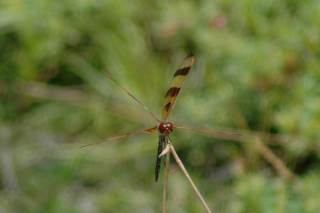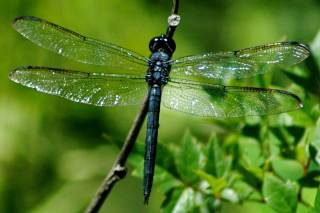Wow, my first-ever Dragonfly Week is already drawing to a close, and I have so many more things I was going to write about! I had planned to at least mention some of the adaptations that go into the incredible aerial feats performed by these “primitive” insects, like their offset thorax, their wings (structurally, they have spars and struts to stiffen the otherwise flimsy “cellophane”; functionally, they have independent 4-wing drive, rather than the “paired” flight evolved by other insects, e.g., Lepidoptera and Hymenoptera; physiologically they have “what may well be the most massive mitochondria in the animal kingdom [Corbet 1999, 397]). But to really go into all of that, I’ll have to do a lot more studying, which I just don’t have time for right now!
I had a lot of fun going through my photo files to find pictures for this week. Just doing that raised my dragonfly sighting list from 16 to 18, with the ID of my two unknowns from 2008: Twilight Darner from T.S. Fay, and the Slaty Skimmer from Fern Forest.
So I thought I’d just share some of the cool things I found out about dragonflies this week, through photos. The image below, of Celithemis eponina (Halloween Pennant) illustrates the “four-wing drive” aspect of dragonfly anatomy. Insects where the hind wing is velcroed to the forewing would not be able to do the “splits” like this:
Try that, Zebra Longwing!
And the image below is another one from the photo files that I uncovered in my searching this week: Libellula incesta (Slaty Skimmer).
I had trouble separating this species from the similar (to beginners like me) Great Blue Skimmer (L. vibrans) until I looked at the wing venation. Since venation is characteristic to species, if you have a good shot of the wings and can compare them to the wings in a field guide, you should be able to nail the ID fairly readily, as long as you don’t have too many look-alikes to sort through!
And that’s kind of a problem, because the skimmers, or Libellulidae, form the largest dragonfly family in the world. They are also the most recently evolved. The name Libellula, which was already current in the 18th century when Dru Drury was naming so many New World insects, appears to come from the diminutive of the Latin name for book, liber; (I suppose that would mean booklet, then). I’m not sure why anyone would name a family of dragonflies after booklets, but that’s what we have.
To close out the week, here is a gallery showing a few of the many dragonflies of south Florida. Enjoy!
References
Corbet, P.S. (1999). Dragonflies: Behavior and Ecology of Odonata. Ithaca: Cornell UP.



















































































